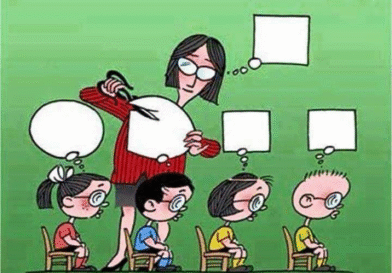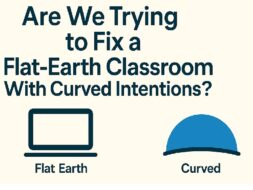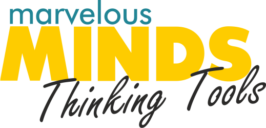The Copy Brain in Chains
At birth, children learn by mimicking. Mirror neurons help them mirror behaviors: smiling, waving, copying words and routines. This is normal and necessary—the Copy Brain is where all learning begins.
But in many classrooms, mimicry becomes the ceiling, not the floor.
Instead of guiding learners toward intentional imitation, strategic thinking, and ultimately self-directed mastery, traditional teaching often reinforces low-level mimicry:
🟡 "Here’s the answer."
🟡 "This is the method."
🟡 "Repeat after me."
It’s a system that treats learners like blank slates—and teachers like content scissors.
✂️ When Teaching Becomes Trimming
In the cartoon, the teacher doesn’t add value—she subtracts individuality. She reshapes a naturally forming idea to fit a rigid format. The rounded bubble, a symbol of original thought, is trimmed into the square shape of compliance.
We see this every day:
- Learners stop asking questions because there’s no time for curiosity.
- A “right answer” becomes more important than a thoughtful process.
- “Show all your steps” becomes code for “Do it exactly like I did.”
🌪 The Cost? Cognitive Fibrillation
When the Copy Brain is overused and the Thinking Brain is underdeveloped, we see cognitive fibrillation—a busy classroom with little actual thinking. Learners are “working,” but their brains aren’t engaged. They’re mimicking, not mastering.
They become students who:
- Say the test was “easy”—but fail (Q4: mimic + overconfidence).
- Freeze at problems they’ve never seen before.
- Depend entirely on examples, unable to transfer strategies to new contexts.
🔧 The Thinking Tools Shift: From Uniformity to Strategy
At the heart of Thinking Tools is a radical idea:
“Learning isn’t about remembering what the teacher said. It’s about figuring things out on your own — guided, scaffolded, and structured.”
Unlike traditional approaches, Thinking Tools activate both the Copy Brain and the Thinking Brain. But more importantly, they connect the two.
They help learners move from:
- Mimicry ➡ Strategic Imitation ➡ Deep Thinking ➡ Mastery.
This is where shape matters: Instead of rounding thoughts only to cut them square again, we let learners build their own frameworks—sometimes curved, sometimes angled—but always theirs.
🚨 A Gentle Warning to Educators
Neural resonance means your learners mirror your thinking—not just your content.
If you model shallow talk-and-chalk delivery, they’ll mirror that passivity.
But if you model structured critical thinking, curiosity, and metacognition—they will mirror that too.
You’re not just teaching what to think.
You’re teaching how to think—and what kind of thinker to become.
🔄 Let’s Trade the Scissors for Scaffolds
The classroom of the future isn’t shaped by the teacher’s scissors—it’s grown through the learner’s brain.
Let’s stop trimming thoughts and start building cognitive bridges.
Let’s replace square answers with spiral growth.
Let’s empower learners to become thinkers.
Because the best education doesn’t standardize thinking.
It unleashes it.





